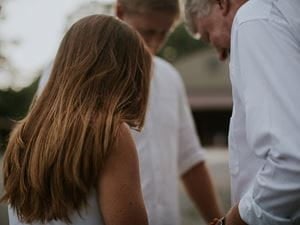
The Glory Be Prayer.
“Glory be to the Father and to the Son and to the Holy Spirit. As it was in the beginning is now, and ever shall be, world without end. Amen.”History and tradition of the Glory Be Prayer.
The Glory Be prayer is most familiar from the Rosary, which is recited at the end of each decade of the Hail Mary. It goes back many centuries and is also known by its Latin name and version as the Gloria Patri (Glory Be to the Father). In some older prayer books and scholarly writings, it is also referred to as a doxology or a fancy name for a short expression of praise for God.
The tradition of doxology comes from the Jewish synagogues. St. Paul often used doxologies similar to the Glory Be in his letters. For example, he referred to “the only wise God, through Jesus Christ, be honor forever and ever. Amen.” at the end of his letter to the Romans in Romans 16:27.
Centuries later, in 1608, the famous bishop St. Francis de Sales ended his classic book Introduction to the Devout Life similarly: “Glory be to Jesus, to Whom, with the Father and the Holy Ghost, be honor and glory, now and ever, and to all Eternity. Amen.” Many people make the cross sign when reciting this prayer or one of its variants which the priest says at the start of Mass: “In the name of the Father, and of the Son and of the Holy Spirit, Amen.”
The Glory Be prayer reaffirms the eternal glory of our “God in Three Persons, Blessed Trinity,” as our Triune God is called in the well-known hymn Holy Holy Holy.
Is the Glory Be Prayer Catholic?
This kind of prayer is found in the Mass and at the end of every psalm or hymn in the Liturgy of the Hours. The collect prayed at the beginning of each Mass closes “. . . through Jesus Christ, your Son, Our Lord, who lives and reigns with you in the unity of the Holy Spirit forever and ever. Amen.” The Eucharistic prayer, which contains the high point of each Mass—the consecration of the bread and wine into the body and blood of Christ—ends with the beautiful “Through him, with him, and in him, in the unity of the Holy Spirit, all glory and honor are yours, Almighty Father, forever and ever. Amen.”
This prayer of glory has been added even to the Our Father, though Our Lord did not include it in his versions of the prayer. Catholics say this after the Our Father at Mass, but many non-Catholics add it every time they pray the Our Father: “For the kingdom, and the power, and the glory are yours, now and forever.” Ending a prayer with this kind of praise was common in Old Testament worship and is often used in the New Testament by St. Paul in his epistles, St. Peter in his letters, and St. John in the book of Revelation.
Meaning of the Glory Be Prayer.
“The “Glory Be” is far from the most common Christian prayer after the Our Father and the Hail Mary. This prayer is called a doxology, from the Greek word meaning an expression of glory or praise. Christians usually use it to sum up their feelings and intentions at the end of some more extended prayer. In a sense, the glory of God is the purpose and the content of all our prayers and actions. So we bring them all together as our act of glorifying God in the Blessed Trinity.
The form of this prayer given in the Catechism of the Catholic Church is the one we teach our children; we use it most often when praying the Rosary, at the end of each decade, or during a set of Hail Marys. When Our Lady prayed the Rosary with St Bernadette at Lourdes, this was the only prayer she said aloud since she would not be saying Hail Marys to herself.
How to use the Glory Be Prayer in personal prayers.
Any prayer that is easily remembered through repetition during church services and reciting traditional prayer can also be used as a personal prayer. You can use the Glory Be prayer as:
- • A way to open or end your prayer times.
- • A breath prayer, which is a prayer that can be mentally or physically recited in the time it takes to breathe in and breathe out. Experiment using different phrases of it as a breath prayer.
- • A song by looking up online the musical tune used in churches.
- • A way for a more profound meditation on the nature of God.
- • A way to turn your eyes off your troubles and onto the eternal nature of God.
- • A way to praise God while in nature.
- • A way to refocus your mind and bring peace.
- • A way to thank God for his goodness.
The words “glory be” mean that we are glorifying God in this prayer. We are giving God the glory that is rightfully His and His alone. Glorify means exalt, worship, praise, honor, adore, thank, and stand in awe.
We glorify God in response to our ability to glimpse a tiny bit of his splendor, majesty, greatness, love, and power. The Bible tells us that God’s glory is so great and overpowering that it would overload our senses to the point of death, as described in Exodus 33:20.
Although we cannot fully see God’s glory, we see reflections of the beauty and majesty of what He has created. Psalms 19:1 says, “The heavens declare the glory of God; the skies proclaim the work of his hands.” We are also privileged to see a reflection of God’s glory through Jesus. The Bible says of Jesus, “The Word became flesh and made his dwelling among us. We have seen his glory, the glory of the One and Only who came from the Father, full of grace and truth.” (John 1:14)
God’s glory attracts us, elevates us, excites us, captures us, transports us, transforms us. God’s glory is also used to draw others to God. It says in the Bible, “Declare His glory among the nations, His marvelous works among all the peoples!” in 1 Chronicles 16:24. God’s glory is a magnificent splendor, and we should all hope to experience it.

